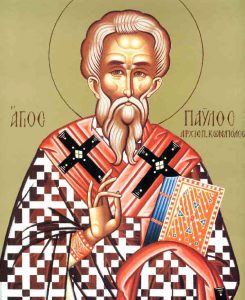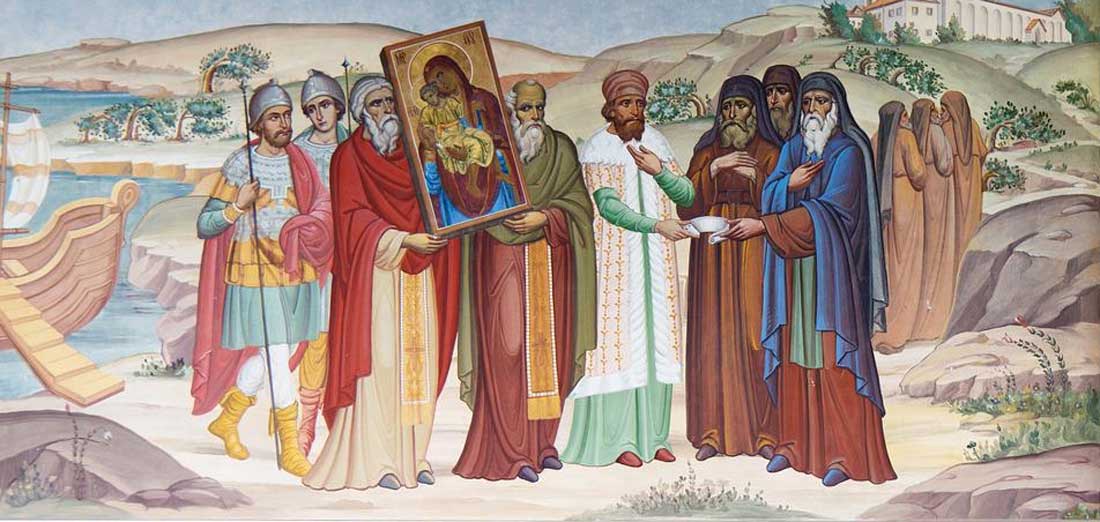Saint Paul Biography
 Saint Paul is a leading figure of Christianity. He converted to Christianity after the death and resurrection of Jesus and emerged as one of its leaders, instrumental in its spread beyond Judaism to become a universal religion. His memory is celebrated by all denominations of Christianity on June 29, together with the Apostle Peter.
Saint Paul is a leading figure of Christianity. He converted to Christianity after the death and resurrection of Jesus and emerged as one of its leaders, instrumental in its spread beyond Judaism to become a universal religion. His memory is celebrated by all denominations of Christianity on June 29, together with the Apostle Peter.
The Jewish Paul was born in Tarsus in Cilicia in 5 and before he became a Christian he was called Saul or Saulos in Greek. However, because he acquired the status of a Roman citizen, he also had a second name, the Roman Paulus (Paul in Greek). In his homeland he learned the Greek language and in Jerusalem he studied Jewish theology under the wise Gamaliel. Also, according to the customs of the time, he also learned an art, that of a stage designer.
He took part in the stoning of Stephen and was full of enmity against the Christians. When he learned that there were many Christians in Damascus, he went to the high priests and got permission and escorts to go arrest them and bring them bound to Jerusalem. A vision he saw on the way to Damascus made him convert to Christianity.
One afternoon, as he was riding his horse toward Damascus, a terrible flash of lightning struck him in the face and threw him to the ground. A voice was heard saying to him:”Saul, Saul why are you persecuting me?” Terrified, Saul replied, “Who are you, Lord?”
“I am Jesus, whom you are persecuting. It’s hard for you to kick over the nails,” the voice replied. Then Saul saw Jesus alive saying to him: “Rise up Saul and go to Damascus. There you will learn what to do.”
Saul got up, but he could not see. He was blind. His companions, intimidated, took him by the hand and brought him into the city, to the house of Judah. There he stayed three days fasting, blind, unable to see anything in front of him. On the third day, at Christ’s command, Ananias went and found him and said to him:
“My brother Saul, Christ appeared to me and commanded me to come and heal you.Indeed, Ananias put it on Saul’s head and immediately after that his eyes were opened, he was enlightened by the Holy Spirit, he believed in Christ and from being a terrible persecutor of Christianity he became the warmest preacher of the Gospel.
Not many days passed and Saul poured into the streets and synagogues of Damascus, preaching Christ. However, because the Jews were thinking of catching him and killing him, the Christians hid him in a house on the edge of the city and at night they brought him down in a basket from the walls outside the city.
From Damascus, Paul went to Jerusalem, where he met many Christians, who welcomed him with joy. He immediately began to preach the Word of God, but again he incurred the hatred and anger of the Jews, who sought a way to kill him. Then, Saul was forced to leave for Caesarea in Palestine and later for his homeland, Tarsus.
From there he went with Barnabas to Antioch in Syria to preach. There, the followers of Christ first took the name Christians. In Antioch, Saul laid out his plans for the propagation and spread of Christianity. For this purpose he chose the major cities of the time and made four tours.
In 45 Paul together with Barnabas and the evangelist Mark set out from Antioch for Seleucia, where they preached. Then by ship they went to Cyprus, where they founded Christian churches. In Paphos the first to believe was the Roman commander Sergius Pavlos. From Cyprus by ship they visited Perga in Asia Minor, Iconium, Lystra and Derbe, where Timothy believed. In 48 Paul went to Jerusalem and took part in the Apostolic Council.
In 52, starting from Antioch, he visited cities in Asia Minor and reached Troy. Timothy, Silas and the evangelist Luke took part in the mission. From Troy he went by ship to Kavala and from there to Philippi, where he founded a church. The first to believe was Lydia and her family. Following the Egnatia road he reached Thessaloniki and Veria. Then he went to Athens, where he preached in the Areopagus the true god. Dionysius the Areopagite and his wife Damaris believed in Athens. Then he went to Corinth and ended up in Ephesus.
In 56 he visited parts of Asia Minor, Greece (Corinth and Macedonia) and then Jerusalem. There the Jews seized him, but the Roman governor sent him to Caesarea in Palestine, where he was imprisoned for two years. He then claimed Roman citizenship and was escorted to Rome to stand trial. In Rome, after spending two years in prison, he was finally tried and acquitted.
Fourth Tour
After he was released, he visited cities in Asia Minor, Crete and Epirus. In 67 he went to Rome and according to some sources he met with the Apostle Peter. But then Nero captured him and put him to death on June 29, when his memory is celebrated.
In addition to preaching for about 30 years, Paul also wrote 14 letters, in which he teaches what should be the behavior of Christians, according to the Gospel.
